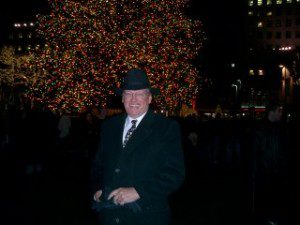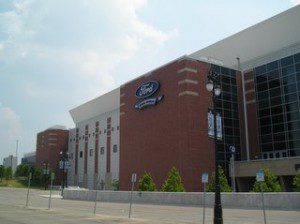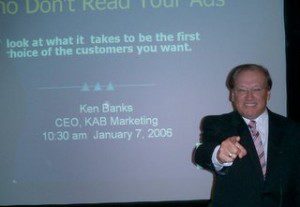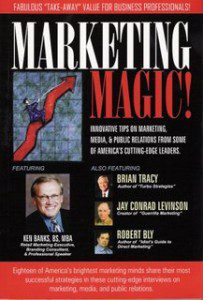 Over the past couple weeks, I’ve had several conversations and phone calls about Wal-Mart’s holiday advertising which broke prior to Thanksgiving. Committed to not making the same mistake as in 2004, Wal-Mart aggressively launched a media blitz to insure that they would get out the blocks selling at 5 a.m. on Black Friday. They launched the holiday with a series of spots featuring celebrities like Garth Brooks, Martina McBride, and Destiny’s Child. Then, they essentially bought out the day before Thanksgiving television networks with spots touting their Friday morning blockbusters with as strong a price/item blitz as I have ever seen from any retailer.
Over the past couple weeks, I’ve had several conversations and phone calls about Wal-Mart’s holiday advertising which broke prior to Thanksgiving. Committed to not making the same mistake as in 2004, Wal-Mart aggressively launched a media blitz to insure that they would get out the blocks selling at 5 a.m. on Black Friday. They launched the holiday with a series of spots featuring celebrities like Garth Brooks, Martina McBride, and Destiny’s Child. Then, they essentially bought out the day before Thanksgiving television networks with spots touting their Friday morning blockbusters with as strong a price/item blitz as I have ever seen from any retailer.
While they claim that 2 million+ shoppers broke down their doors in the first two hours on Black Friday to get their $398 laptops and $179 flat screen televisions, I’m afraid that the world’s #1 retailer forgot that this is the season to remember what got you to the top spot in the first place.
It certainly isn’t running a feel-good campaign with big names singing nice songs, which looked a lot like Target campaigns of old. Actually, these reminded me of campaigns that used to make Dayton’s and Marshall Field’s the place for holiday shopping when department stores were just that. I don’t think running department store type of spots is what has made Wal-Mart the shoppers destination store all year long as well as the holidays. Then to come back with a price-item campaign for Friday morning specials when you have been touting “Always low prices. Always” for years just to make traffic goals for 7 hours on Friday seems really contradictory. Granted having an exclusive boxed CD set from Garth Brooks (even though he’s been retired for 4 years) is a real merchandising coup. But to go and break prices on laptops that cause people to trample each other just getting into the store and then have fist fights over one of only six that were in stock that morning does nothing but put you in the same boat that nearly sunk Kmart years ago. The news is filled with reports trying to discredit the company now that it’s so big. Why do they have to resort to old time tactics that not only disappoint customers who are used to being able to get what they see advertised at Wal-Mart but also to undermine the trust that they have so effectively built on their march to the top?
It seems they forgot what got them there. Real people talking about real savings on real items they want that are in stock. No doubt Wal-Mart’s campaign needed a fresh look and inspired outlook, but simply running a campaign that looks and feels like those done by the very retailers they took market share from every year is really a step backwards.
The New York Times reported that Black Friday sales were down .9% from last year and that it was a “lukewarm” sales day. I actually went to Wal-Mart on Black Friday at about 4:30pm (you think I’m crazy enough to be there at 4:30 AM?) to see what was happening and pick up some outdoor lights as well. There were no lines at the registers, there were no traces of the blockbuster items, and it was as exciting (from a customer standpoint)as a Friday in mid-August. It sure isn’t the way I remember holiday sales from years ago. ‘Tis the season!
Here’s to you and your–hope your holiday is more exciting!
Happy Holidays!
Ken

 Over the past several days, there has been a lot of conversation about this year’s round of Super Bowl Commercials and whether they were worth the $2.4 Million price tag for the mere thirty seconds of air time. Frankly, I thought that this year’s crop fared better than the past couple years and actually were much better in terms of excitement and surprise than the game itself (I’m sure there are some Steelers fans who would disagree).
One of the things that struck me, however, was seeing the Ford Field signs throughout the coverage over the two weeks leading up to the game. I’m sure Ford must have felt proud that they spend the mega-millions in stadium naming fees when they saw all of the coverage. Just as they do when they watched Phil Mickelson in the FBR Open from Phoenix as he sported the Ford logo on his shirt even if he didn’t fare so well on the final 18 holes. I’m sure that GM must be proud of its title sponsorship of the Buick Opens (how many are there, anyway?)
You can’t help but wonder if these “product placements” could offset the recent bad news out of Detroit for both of these major car companies. Both announced major cutbacks and plant closing to “revitalize” these companies and their automotive brands. Do they really need the heightened awareness of seeing their names at these sporting events when Toyota has now taken over the lead as America’s most popular car brand?
Over the past several days, there has been a lot of conversation about this year’s round of Super Bowl Commercials and whether they were worth the $2.4 Million price tag for the mere thirty seconds of air time. Frankly, I thought that this year’s crop fared better than the past couple years and actually were much better in terms of excitement and surprise than the game itself (I’m sure there are some Steelers fans who would disagree).
One of the things that struck me, however, was seeing the Ford Field signs throughout the coverage over the two weeks leading up to the game. I’m sure Ford must have felt proud that they spend the mega-millions in stadium naming fees when they saw all of the coverage. Just as they do when they watched Phil Mickelson in the FBR Open from Phoenix as he sported the Ford logo on his shirt even if he didn’t fare so well on the final 18 holes. I’m sure that GM must be proud of its title sponsorship of the Buick Opens (how many are there, anyway?)
You can’t help but wonder if these “product placements” could offset the recent bad news out of Detroit for both of these major car companies. Both announced major cutbacks and plant closing to “revitalize” these companies and their automotive brands. Do they really need the heightened awareness of seeing their names at these sporting events when Toyota has now taken over the lead as America’s most popular car brand? I was talking recently with a senior marketing executive with one of the country’s top retail chains about an upcoming presentation that I was scheduled to give in San Antonio (see photo above). During the course of our discussion, I asked her if she had given any presentations lately and her response was that “Absolutely not. Our company has a firm policy which prohibits executives making any speeches or participating in any discussions about the company’s plans or activities.” The rationale was that all this did was give the competitor’s more information than they should have. Having done a lot of speeches in my retail days, I was surprised since I always felt there may be a potential investor and certainly potential customers in the audience and that the information was always limited to facts that any good competitor would have been aware of if they were monitoring the marketplace on a regular basis.
I was talking recently with a senior marketing executive with one of the country’s top retail chains about an upcoming presentation that I was scheduled to give in San Antonio (see photo above). During the course of our discussion, I asked her if she had given any presentations lately and her response was that “Absolutely not. Our company has a firm policy which prohibits executives making any speeches or participating in any discussions about the company’s plans or activities.” The rationale was that all this did was give the competitor’s more information than they should have. Having done a lot of speeches in my retail days, I was surprised since I always felt there may be a potential investor and certainly potential customers in the audience and that the information was always limited to facts that any good competitor would have been aware of if they were monitoring the marketplace on a regular basis. This year I was honored to be a contributor to the Book “Marketing Magic” from Insight Publishing. This book features 18 interviews with marketing experts from various backgrounds and expertise, including Brian Tracy, author of “Turbo Strategies”, and Jay Conrad Levinson, author of “Guerilla Marketing” and yours truly. I offer this book at my presentations for the list price of $19.95, but wanted to offer my blog readers a special offer. It’s yours FREE if you just send me the names of five other executives who might benefit from my monthly blog. Or if you want to order a quantity for you and your staff, it’s only $10 a copy(plus shipping). Just send me an email, and I will send the book to you right away.
This year I was honored to be a contributor to the Book “Marketing Magic” from Insight Publishing. This book features 18 interviews with marketing experts from various backgrounds and expertise, including Brian Tracy, author of “Turbo Strategies”, and Jay Conrad Levinson, author of “Guerilla Marketing” and yours truly. I offer this book at my presentations for the list price of $19.95, but wanted to offer my blog readers a special offer. It’s yours FREE if you just send me the names of five other executives who might benefit from my monthly blog. Or if you want to order a quantity for you and your staff, it’s only $10 a copy(plus shipping). Just send me an email, and I will send the book to you right away.
Recent Comments